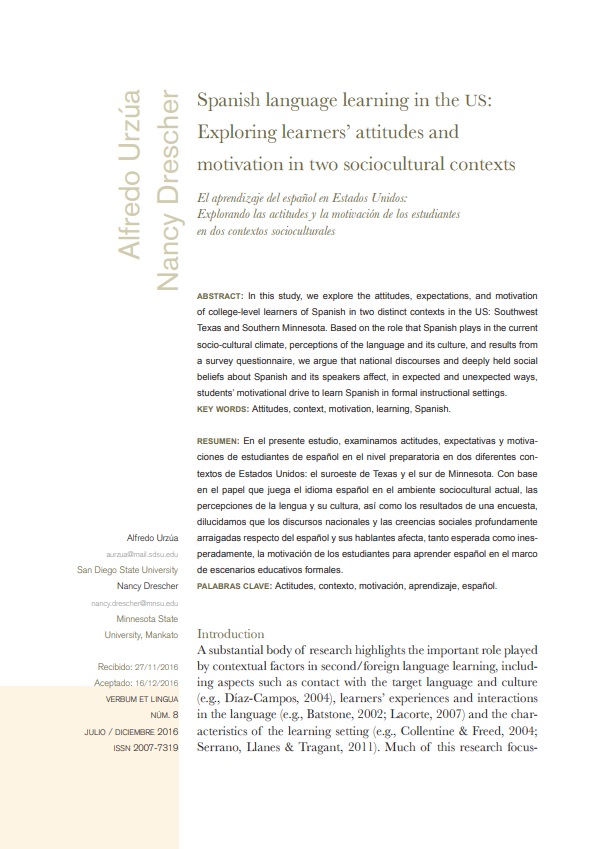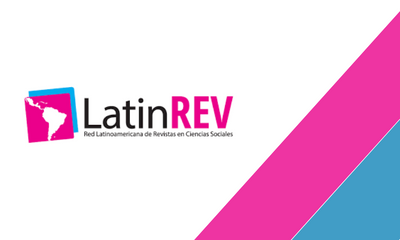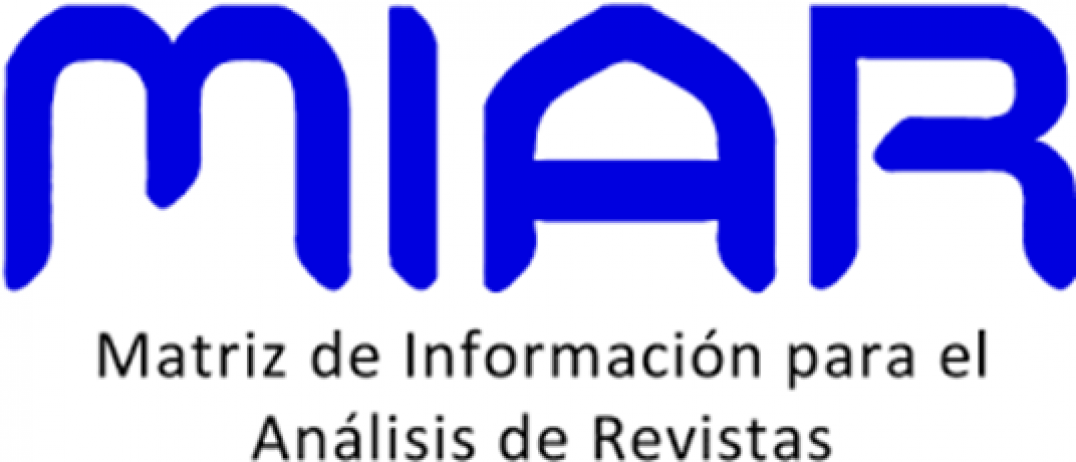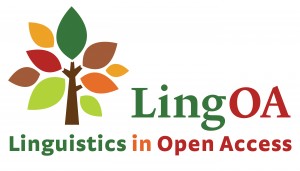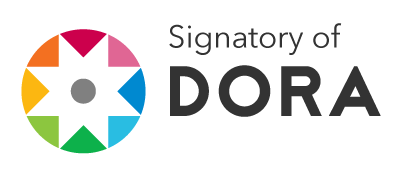EL aprendizaje del español en Estados Unidos: Explorando las actitudes y la motivación de los estudiantes en dos contextos socioculturales
DOI:
https://doi.org/10.32870/vel.vi8.79Palabras clave:
Actitudes, contexto, motivación, aprendizaje, españolResumen
En el presente estudio, examinamos actitudes, expectativas y motivaciones de estudiantes de español en el nivel preparatoria en dos diferentes contextos de Estados Unidos: el suroeste de Texas y el sur de Minnesota. Con base en el papel que juega el idioma español en el ambiente sociocultural actual, las percepciones de la lengua y su cultura, así como los resultados de una encuesta, dilucidamos que los discursos nacionales y las creencias sociales profundamente arraigadas respecto del español y sus hablantes afecta, tanto esperada como inesperadamente, la motivación de los estudiantes para aprender español en el marco de escenarios educativos formales.
Descargas
Métricas
Citas
Abrams, Z. (2002). Surfing the cross-cultural awareness: Using internet-mediated projects to explore cultural stereotypes. Foreign Language Annals, 32 (2), 141-160.
Albakry, M. (2010). Analyzing the discourse of immigration in us newspapers. Paper presented at the March 7th, 2010 Conference of the American Association ofApplied Linguistics. Atlanta, ga, ee.uu.
Barker, V. & Giles, H. (2004). English-only policies: Perceived support and social limitation. Language & Communication, 24, 77-95.
Batstone, R. (2002). Contexts of engagement: A discourse perspective on “intake” and “pushed output”. System, 30,1-14.
Beaudrie, S., Ducar, C. & Relaño-Pastor, A. M. (2009). Curricular perspectives in the heritage language context: Assessing culture and identity. Language, Culture and Curriculum, 22 (2), 157-174.
Brod, R. & Welles, E. B. (2000). Foreign language enrollments in United States institutions of higher education-Fall 1998. adfl Bulletin, 31, 22-29.
Bureau of Transportation Statistics-bts. (2014). Border crossing/entry data: Query detailed statistics. Retrieved on July 10, 2014 from https://transborder.bts.gov/programs/international/transborder/TBDR_BC/TBDR_BCQ.html
Chavez, M. (2002) We say “culture” and students ask “what?”: University students’ definitions of foreign language culture. Die Unterrichtspraxis/Teaching German, 35 (2), 129-140.
Chavez, L. R. (2008). The Latino threat: Constructing immigrants, citizens, and the nation. Stanford, ca, ee.uu.: Stanford University Press.
Collentine, J. & Freed, B. F. (2004). Learning context and its effects on second language acquisition. Studies in Second Language Acquisition, 26, 153-171.
Csizér, K. & Dörnyei, Z. (2005). The internal structure of language learning motivation and its relationship with language choice and learning effort. Modern Language Journal, 89 (1), 19-36.
Díaz-Campos, M. (2004). Context of learning in the acquisition of Spanish second language phonology. Studies in Second Language Acquisition, 26, 249-273.
Dörnyei, Z. & Csizér, K. (2005). The effects of intercultural contact and tourism on language attitudes and language learning motivation. Journal of Language and Social Psychology, 24 (4), 327-357.
Gardner, R. C. (1985). Social psychology and second language learning: The role of attitudes and motivation. Baltimore, md, ee.uu.: Arnold.
Gardner, R. C. (2001). Integrative motivation and second language acquisition. In Z. Dörnyei & R. Schmidt (Eds.), Motivation and second language acquisition (pp. 1-20). Honolulu, Hawaii: University of Hawaii Press. núm. 8 / julio-diciembre / 2016 73
Gibson, K. (2004). English only court cases involving the U.S. workplace. Second Language Studies, 22 (2), 1-60.
Glisan, E. W. (1987). Beginning Spanish students: A survey of attitudes at the University of Pittsburgh. Hispania, 70, 381-394.
Henderson, T. J. (2011). Beyond borders: A history of Mexican migration to the United States. Malden, ma, ee.uu.: Wiley-Blackwell.
Kanno, Y. & Norton, B. (2003). Imagined communities and educational possibilities: Introduction. Journal of Language, Identity and Education, 2 (4), 241-249.
Lacorte, M. (2007). Interacción y contexto(s) en el aprendizaje y enseñanza de español como L2. Spanish in Context, 4 (1), 73-98.
Lee, L. (2012). Engaging study abroad students in intercultural learning through blogging and ethnographic interviews. Foreign Language Annals, 45 (1), 7-21.
Leeman, J. (2004). Racializing language: A history of linguistic ideologies in the us census. Journal of Language and Politics, 3 (3), 507-534.
Mandell, P. B. (2002). On the background and motivation of students in a beginning Spanish program. Foreign Language Annals, 35 (5), 530-542.
Marrero, P. (2012). Killing the American dream. New York, ee.uu.: Palgrave Macmillan.
Martinez-Brawly, E. & Gualda, E. (2009). Portraying immigrants to the public: Mexican workers in the usa and African workers in Spain. International Social Work, 52 (3), 299-312.
McGroarty, M. (2001). Situating second language motivation. In Z. Dornyei & R. Schmidt (Ed.), Motivation and second language acquisition-Technical Report #23 (pp. 69-91). Honolulu, Hawaii: University of Hawaii-Language Resource Center.
Méndez-Méndez, S. & Alverio, D. (2003). Network Brownout 2003: The portrayal of Latinos in network television news, 2002 Report. Washington, dc, ee.uu.: National Association of Hispanic Journalists.
Modern Language Association-mla. (2007). New mla survey shows significant increases in foreign language study at the U.S. colleges and universities. Retrieved on February 5, 2013 from http://www.mla.org/pdf/release11207_ma_feb_update.pdf.
National Standards for Foreign Language Education. (1996). Standards for foreign
language learning: Preparing for the 21st century. American Council on the Teaching of Foreign Languages. Retrieved on March 4, 2013 from https://www.actfl.org/sites/default/files/publications/standards/1996%20National%20Standards%20for%20FL%20L%20Exec%20Summary.pdf.
Norton [Peirce], B. (1995). Social identity, investment, and language learning. tesol Quarterly, 29 (1), 9-31.
Odem, M. E. & Lacy, E. C. (2009). Latino immigrants and the transformation of the U.S. South. Athens, ga, ee.uu.: University of Georgia Press.
Ortega, L. (2009). Understanding second language acquisition. London, uk: Hooder Education.
Ossipov, H. (2000). Who is taking French and why? Foreign Language Annals, 33 (2), 157-67.
Pavlenko, A. (2002). “We have room for but one language here”: Language and national identity in the us at the
turn of the 20th century. Multilingua, 21, 163-196. 74 Alfredo Urzúa, Nancy Drescher. Spanish language learning in the us:...
Serrano, R., Llanes, A. & Tragant, E. (2011). Analyzing the effect of context on second language learning: Domestic intensive and semi-intensive courses vs. study abroad in Europe. System, 39, 133-143.
Thomas, J. A. (2010). How do I satisfy the general education language requirement? University students’ attitudes toward language study. Foreign Language Annals, 43 (3), 531-551.
us Census Bureau. (2010a). acs demographic and housing estimates, 2007- 2011. American FactFinder: Community facts. Retrieved on February 5, 2013 from http://factfinder2.census.gov/faces/tableservices/jsf/pages/productview.xhtml?pid=ACS_11_5YR_DP05
us Census Bureau (2010b). Language use in the United States: 2007. Retrieved on February 5, 2013 from http://www.census.gov/prod/2010pubs/acs-12.pdf
us Census Bureau (2010c). Quick facts from the US Census Bureau. Retrieved on February 5, 2013 from https://www.census.gov/quickfacts/
us Census Bureau (2010d). Quick facts from the US Census Bureau. Retrieved on February 5, 2013 from https://www.census.gov/quickfacts/
Voght, G. M. (2000). New paradigms for US higher education in the twenty first century. Foreign Language Annals, 33 (3), 269-277.
Wen, X. (1997). Motivation and language learning with students of Chinese. Foreign Language Annals, 30 (2), 235-251.
